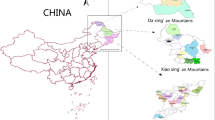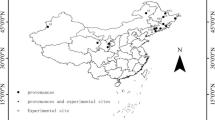Abstract
Biomass additivity is a desirable characteristic of a system of equations for predicting component as well as total tree biomass since it eliminates the inconsistency between the sum of predicted values for components such as stem, bark, branch and leaf and the prediction for the total tree. Besides logical consistency, a system of additive biomass equations when estimated by taking into account the inherent correlation among the biomass components has greater statistical efficiency than separately estimated equations for individual components. Using mostly small sample data from both published and unpublished sources, a system of non-linear additive biomass equations was developed for 15 native eucalypt forest tree species of temperate Australia. Diameter at breast height was used as the independent variable for all 15 species, while the combined variable of diameter and tree height was used for 14 species with height data. The system of additive equations provided more accurate biomass estimates than the common approach of separately fitting total tree and component biomass equations using log transformed data through least squares regression. Residual error variances were collectively estimated for each species by pooling small sample data across species and using indicator variables to represent the scale factor for each species in a residual variance function. This method overcame a common problem in estimating heteroscedastic error variance in non-linear biomass equations with additive error terms for small samples. From the estimated residual variance functions, approximate confidence bands containing about 95% of the observed data about the mean curve of predicted biomass were derived for all biomass components of each species. This system of additive biomass equations will prove to be useful for biomass estimation of native eucalypt forests of temperate Australia.





Similar content being viewed by others
References
Adams MA, Attiwill PM (1988) Nutrient cycling in forests of north-east Tasmania. Research Report No. 1. Tasmanian Forest Research Council, Hobart
Amemiya T (1985) Advanced econometrics. Harvard University Press, Cambridge
Applegate GB (1982) Biomass of blackbutt (Eucalyptus pilularis Sm.) forests on Fraser Island. MSc Thesis. University of New England, Armidale
Attiwill PM (1992) Productivity of Eucalyptus regnans forest regenerating after bushfire. S Afr For J 160:1-6
Baker TG, Attiwill PM (1985) Above-ground nutrient distribution and cycling in Pinus radiata (D. Don) and Eucalyptus obliqua (L’Herit) forests in south-eastern Australia. For Ecol Manage 13:41-52
Bi H (1999) Predicting stem volume to any height limit for native tree species in southern New South Wales and Victoria. N Z J For Sci 29:318-331
Bi H (2000) Trigonometric variable-form taper equations for Australian eucalypts. For Sci 46:397-409
Bi H, Hamilton F (1998) Stem volume equations for native tree species in southern New South Wales and Victoria. Aust For 61:275-286
Bi H, Birk E, Turner J, Lambert M, Jurskis V (2001) Converting stem volume to biomass with additivity, bias correction, and confidence bands for two Australian tree species. N Z J For Sci 31:298-319
Bierens HJ (2002) EasyReg International. Department of Economics, Pennsylvania State University, University Park, Pa.
Birk EM, Turner J (1992) Response of flooded gum (E. grandis) to intensive cultural treatments: biomass and nutrient content of eucalypt plantations and native forests. For Ecol Manage 47:1-28
Boland DJ, Brooker MIH, Chippendal GM, Hall N, Hyland BPM, Johnson RD, Kleinig DA, Turner JD (1992) Forest trees of Australia. CSIRO, Australia
Burrows WH, Hoffmann MB, Compton JF, Back PV, Tait LJ (2000) Allometric relationships and community biomass estimates for some dominant eucalypts in Central Queensland woodlands. Aust J Bot 48:707-714
Carvalho JP, Parresol BR (2003) Additivity in tree biomass components of Pyrenean oak (Quercus pyrenaica Willd.). For Ecol Manage 179:269-276
Chiyenda SS, Kozak A (1984) Additivity of component biomass regression equations when the underlying model is linear. Can J For Res 14:441-446
Cunia T, Briggs RD (1984) Forcing additivity of biomass tables: some empirical results. Can J For Res 14:376-384
Cunia T, Briggs RD (1985) Forcing additivity of biomass tables: use of the generalised least squares method. Can J For Res 15:23-28
Eamus D, McGuinness K, Burrows W (2000) Review of allometric relationships for estimating woody biomass for Queensland, the Northern Territory and Western Australia. National Carbon Accounting System, Technical Report No. 5a. Australian Greenhouse Office, Canberra
Feller MC (1980) Biomass and nutrient distribution in two eucalypt forest ecosystems. Aust J Ecol 5:309-333
Florence RG (1961) Ecology of blackbutt. PhD thesis. Sydney University, Sydney
Florence RG (1996) Ecology and silviculture of eucalypt forests. CSIRO, Collingwood, Australia
Gallant AR (1975) Seemingly unrelated non-linear regressions. J Econometrics 3:35-50
Greene WH (1999) Econometric analysis, 4th edn. Prentice Hall, Upper Saddle River, N.J.
Groves TS, Malajczuk N (1985) Biomass production in trees and understory shrubs in an age-series of Eucalyptus diversicolor F. Muell. stands. For Ecol Manage 11:59-74
Hinston FJ, Turton AG, Dimmock GM (1979) Nutrient distribution in karri (Eucalyptus diversicolor F. Muell.) ecosystems in southwest Western Australia. For Ecol Manage 2:133-158
Jacobs MR (1955) Growth habits of the eucalypts. Commonwealth Government Printer, Canberra
Judge GG, Hill RC, Griffiths WE, Lutkepohl H, Lee TC (1988) Introduction to the theory and practice of econometrics, 2nd edn. Wiley, New York
Keith H, Barrett D, Keenan R (2000) Review of allometric relationships for estimating woody biomass for New South Wales, the Australian Capital Territory, Victoria, Tasmania and South Australia. National Carbon Accounting System, Technical Report No. 5b. Australian Greenhouse Office, Canberra
Ketterings QM, Coe R, Noordwijk M van, Ambagau Y, Palm CA (2001) Reducing uncertainty in the use of allometric biomass equations for predicting above-ground tree biomass in mixed secondary forests. For Ecol Manage 146:199-209
Kozak A (1970) Methods for ensuring additivity of biomass components by regression analysis. For Chron 46:402-404
Lambert MJ (1979) Sulphur relationships of native and exotic tree species. MSc (Hons) Thesis. Macquarie University, Australia
O’Grady AP, Chen X, Eamus D, Hutley LB (2000) Composition, leaf area index and standing biomass of eucalypt open forests near Darwin in the Northern Territory, Australia. Aust J Bot 48:629-638
Overman JPM, Witte HJL, Saldarriaga JG (1994) Evaluation of regression models for above-ground biomass determination in Amazon rainforest. J Trop Ecol 10:207-218
Parresol BR (1999) Assessing tree and stand biomass: a review with examples and critical comparison. For Sci 45:573-593
Parresol BR (2001) Additivity of nonlinear biomass equations. Can J For Res 31:865-878
Reed DD, Green EJ (1985) A method of forcing additivity of biomass tables when using nonlinear models. Can J For Res 15:1184-1187
SAS (1988) SAS/ETS user’s guide, version 6, 2nd edn. SAS Institute, Cary
Satoo T, Madgwick HAI (1982) Forest biomass. Nyhoff-Junk, The Hague
Sephton PS (1998) EasyReg: version 1.12. J Appl Econometrics 13:203-207
Specht RL (1970) Vegetation. In: Leeper GW (ed) The Australian environment, 4th edn. The Dominion, North Blackburn, Victoria, Australia, pp 44-67
Srivastava VK, Giles DA (1987) Seemingly unrelated regression equations models: estimation and inference. Dekker, New York
Stewart HTL, Flinn DW, Aeberli BC (1979) Above-ground biomass of mixed eucalypt forest in Eastern Victoria. Aust J Bot 27:725-740
Ter-Mikaelian MT, Korzukhin MD (1997) Biomass equations for sixty-five North American tree species. For Ecol Manage 97:1-24
Turner J, Kelly J (1985) Effect of radiata pine on soil chemical characteristics. For Ecol Manage 11:257-270
Turner J, Lambert MJ (1986) Effects of forest harvesting nutrient removals on soil nutrient reserves. Oecologia 70:140-148
Turner J, Lambert MJ (2004) Nutrient cycling in two Eucalyptus plantation species. New For (in press)
Turner J, Lambert MJ, Holmes G (1992) Nutrient cycling in forested catchments in southeastern New South Wales. I. Biomass accumulation. For Ecol Manage 55:135-148
Wackerly DD, Mendenhall W, Scheaffer RL (1996) Mathematical statistics with applications. Duxbury, Belmont
Zellner A (1962) An efficient method of estimating seemingly unrelated regressions and tests for aggregation bias. J Am Stat Assoc 57:348-368
Acknowledgements
We would like to thank Shimin Cai for technical assistance and our colleagues Drs. Yushan Long, Craig Barton, Sandra Roberts and Mr. Jack Simpson for helpful comments on the manuscript.
Author information
Authors and Affiliations
Corresponding author
Rights and permissions
About this article
Cite this article
Bi, H., Turner, J. & Lambert, M.J. Additive biomass equations for native eucalypt forest trees of temperate Australia. Trees 18, 467–479 (2004). https://doi.org/10.1007/s00468-004-0333-z
Received:
Accepted:
Published:
Issue Date:
DOI: https://doi.org/10.1007/s00468-004-0333-z




